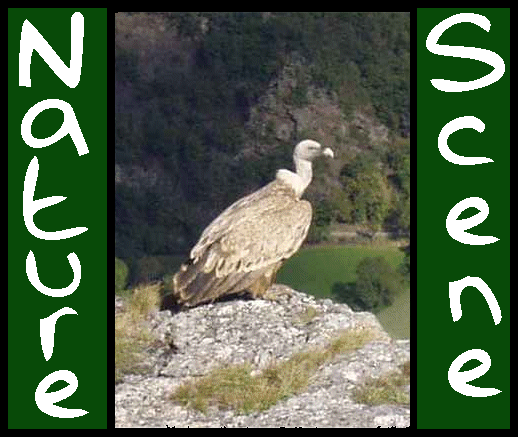
Welcome to NATURESCENE'S
BOTANY ARTICLES of the CÉVENNES
A selection of articles in French and English by David Dickenson of Naturescene, and Alain Jacquet of ALEPE, written for the official ALEPE site

|
Alain has the privilege to begin: 27 people, all nature-lovers, met for the outing at La Bourgarie to immerse themselves in discovering and identifying the local wild orchids. As we moved off towards Volcégur, a slightly hazy sun warmed the dry grasslands where we began our search. Several Griffon vultures flew over us as they came to greet our arrival. |
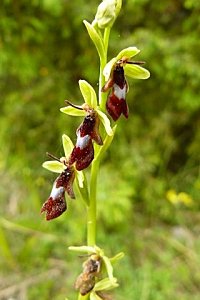
Photo 1 |
We managed to find 15 species of wild orchids: the Fragrant Orchid (Gymnadenia conopsea), with its very long spur which ensures it is only visited by the long proboscis of certain butterflies, were set amongst Military, Monkey, Lady, Burnt and Early Purple Orchids. The short-cropped turf sparkled with the deep pink of the flowers of the Pyramidal Orchid, just bursting open. The discrete Fly Orchid (Ophrys insectifera) (photo 1) showed off its blue mirror and long lip, which so resembles a wasp's abdomen. |
|
We felt quite privileged when we came across the Early Fly Orchid (Ophrys aymoninii) (photo 2) , with its large
yellow border.
This species is endemic to the Causses, that is to say, it only exists in the limestone plateaus of Lozère and the Aveyron. |
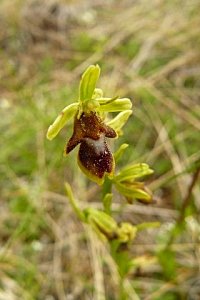
Photo 2 |
|
As we approached the wooded slopes, we spotted the large brilliant white flowering spikes of the
Sword-leafed Helliborine (Cephalanthera longifolia), the gentle pink of the Spotted Orchid
(Dactylorhiza fuschii) and the comical Greater butterfly orchid (Platanthera chlorantha) (photo 3) which was poking its
tongue out at us!
Returning to La Bourgarie along the path, under a gentle shower that failed to discourage us, we saw a scattering of Green Winged Orchids (Anacamptis moris), with their green-striped hoods, and the flowering stalks of the Lizard Orchid (Himantoglossum hircinum) about to spring open. |
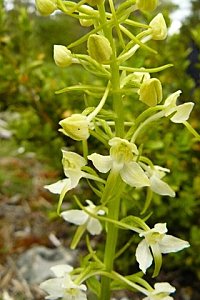
Photo 3 |
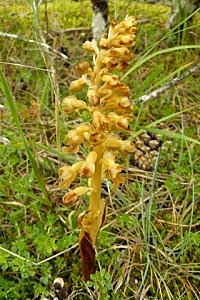
Photo 4 |
After a picnic fighting off a few drops of rain, we took the cars in the direction of the Roc des Hourtous.
Four other species of orchid were awaiting us there. Under the pines, we spotted the
Birds Nest Orchid (Neottia nidus-avis) (photo 4). The entire plant was beige from stalk to flower, without a single leaf,
for this plant cannot feed itself.
Its roots are intricately entwined with a filamentous fungus, which is itself intertwined with the roots of the pines. Thanks to these fungi, this orchid derives all its food from these trees, which perform the photosythesis for them! |
|
We were pleased to find a second additional species, the White Helliborine (Cephalanthera damasonuim) (photo 5), whose
French name of Yellowish-flowered Cephalanth more closely fits the bill, as it is neither white nor a Helliborine.
We also came across some Twayblades (Listera ovata), which is one of the most discrete orchids, hiding in the under-brush with greenish flowers. |
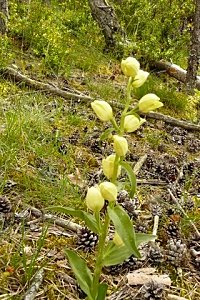
Photo 5 |
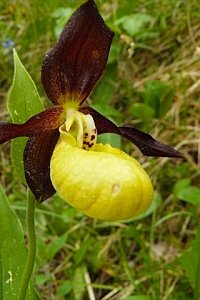
|
Our 19th orchid species invited us to approach it at the end of the day, with its large protruding yellow lip, looking like a slipper, surrounded by its dark brown petals and sepals, strap-like and twisted. It had to be beautiful to be called the Lady's Slipper Orchid (Cypripedium calceolus) (photo 6)! |
................. Following text and photos by David Dickenson (photos taken on a sunnier day!) ................Other flowers of interest |
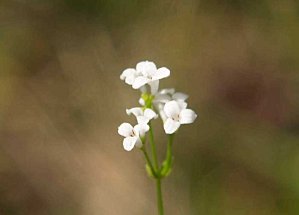
Photo 7 |
As Alain has said, in addition to the orchids that were abundant in both numbers and variety, there were many other exciting discoveries. One of the rarest plants to find was the Dyer's Woodruff (Apserula tinctoria) (photo 7) with its 3 petals, an unusual feature for a member of the Rubiaceae family. We all enjoyed the Dwarf Blue Thistles (Cardoncellus mitissimus) (photo 8), which resembled the later-flowering Stemless Thistle (Cirsium acaule), but without spiny leaves. |
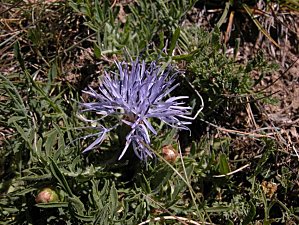
Photo 8 |
| At the last stage of our outing, in competition with the Lady's Slipper Orchid, were some carnivorous plants, a subspecies of the Long-Leaved Butterwort endemic to the Causses (Pinguicula longifolia subsp. caussensis) (photo 9). Right next to them was another endemic plant, the Gentian of the Causses (Gentiana clusii subsp. costei) (photo 10). The day was too dark for it to open its petals, thus I have put on line a photo from a sunnier time. |
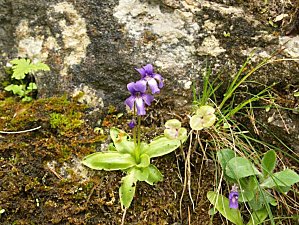
Photo 9 |
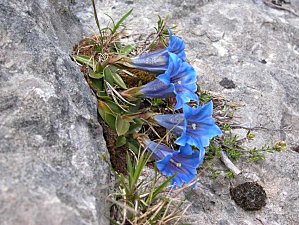
Photo 10 |
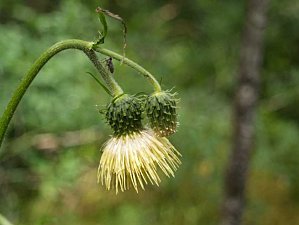
Photo 11 |
Our group also missed out on the rare Melancholy Thistle (Cirsium erisithales) (photo 11). We saw several in bud, and if we had returned to see the open flowers a fortnight later, we would have seen why the flower got its name. | |
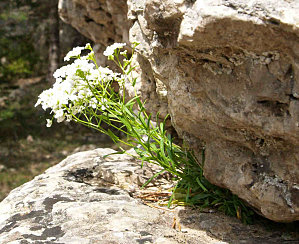
Photo 12 |
Just beside the butterworts we were attracted to the white clusters of Kernera (Kernera saxatilis) (photo 12), typical of dolomitic rocks, and close by, some Solomon's Seal (Polygonatum odoratum) (photo 13), so loved in English gardens. |
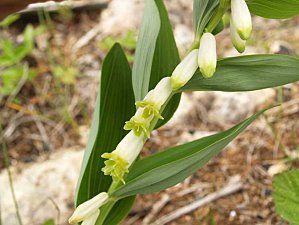
Photo 13 |
| Speaking of aromatic plants, was I alone in pausing by the Lady's Slipper and inhaling the intoxicatingly perfumed leaf of Nestler's Sermountain (Laserpitium nestleri) (photo 14)? Yes, if it is not edible, the French are not interested. |
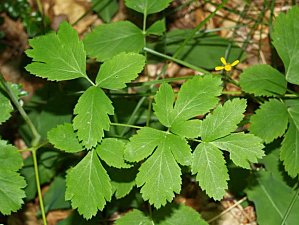
Photo 14 |